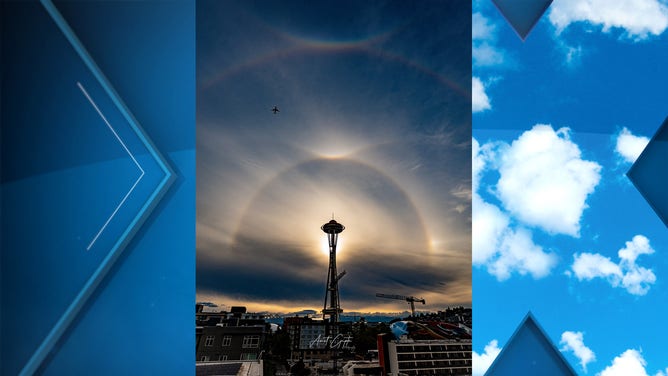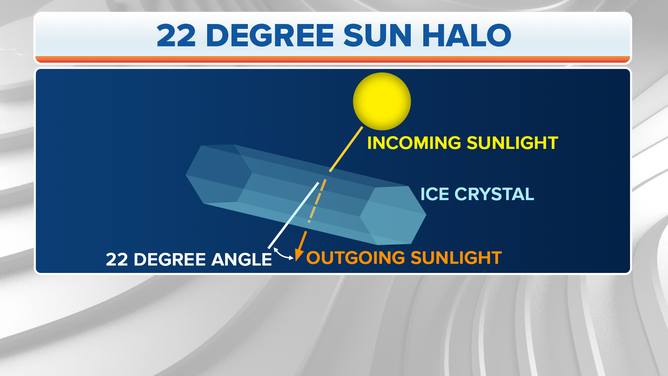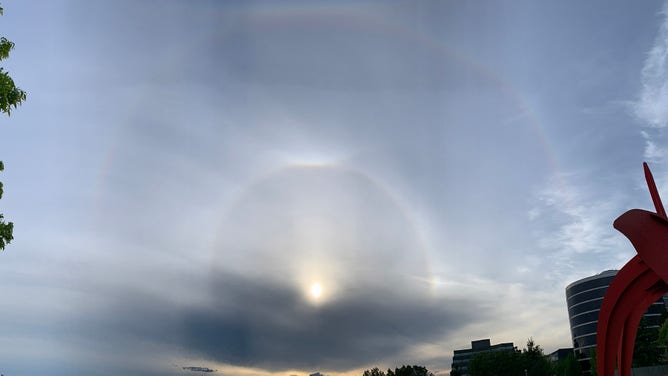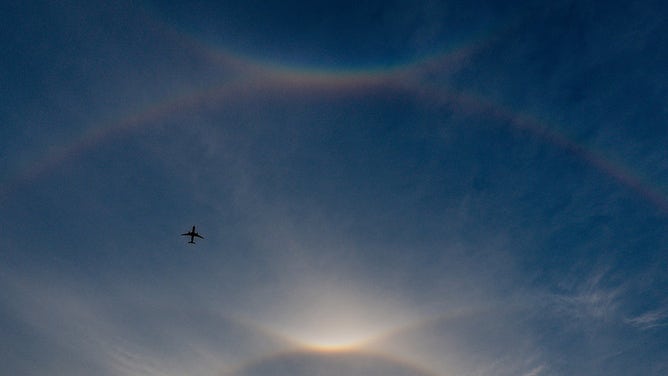Sun-sational sight: Seattle area gets colorful signal that rain is on the way
Multiple atmospheric optic displays were spotted in Seattle Sunday, including a 22-degree halo, sun dogs, and tangential arcs, all framed around the iconic Space Needle.

A 22 degree halo, sun dogs and tangent arcs put on a spectacular display over Seattle's Space Needle on May 22, 2022.
(Amit Gupta / @guptamit13)
SEATTLE – Mother Nature put on an optical show of the ages Sunday evening around the Seattle area, painting several colorful halos and arcs around the sun.
The photo above by photographer Amit Gupta shows multiple refraction effects, including a 22-degree halo, sun dogs, and tangential arcs, all framed around the iconic Space Needle.
WHY IS THERE A RAINBOW AROUND THE SUN?
The multiple displays were triggered by the various shapes and sizes of ice crystals in those thin cirrus and cirrostratus clouds that rolled into the region Sunday.
The half-circle "rainbow" around the Space Needle is called a 22-degree halo and though it looks like a rainbow, it’s not quite the same.
"Some people might call it a rainbow around the sun, but it's actually caused by ice crystals," says scientist Michael Kavulich with the National Center for Atmospheric Research.
That difference is critical. Raindrops are spherical, but the ice crystals have six sides, similar to snowflakes, which refract sunlight at a different angle.

(FOX Weather)
"Just like rain, sunlight will go into the ice, and it will be refracted. And so the red and blue light will be refracted at slightly different angles," Kavulich said. "And in this case, because it's ice, it happens to be at a 22-degree angle."
Not Quite The Dog Days of Summer…
And on the right and left edge of the halo are two brighter spots of light – those are "sun dogs."
"Sun dogs are formed when you have more orderly ice crystals," Kavulich says.
In this case, we have what is known as plate crystals that are six-sided shapes with flat tops but have some thickness to them.
"So it's kind of like a dinner plate, and those actually tend to fall slowly - almost kind of fall straight down like a leaf," he said.

A 22 degree halo, sun dogs and tangent arcs put on a spectacular display over Seattle on May 22, 2022.
(David Jensen)
Sunlight hitting the top and bottom of the flat parts of the crystals will reflect sunlight like a mirror. But sunlight that goes in the thick sides of crystals will refract into rainbow colors, similar to a prism.
"And since that angle (of refraction) is 22 degrees, you see two bright spots on either side of the sun," he said. Though sometimes it may only be on one side, depending on where the high clouds are in reference to the sun.
HOW TO WATCH FOX WEATHER ON TV
The arc at the top of the 22-degree halo is known as an "upper tangent arc". Similar to the other arcs, they’re formed by the alignment of certain ice crystals and how they refract the sunlight.

The circumzenithal arc and upper tangent arc in Seattle on May 22, 2022.
(Amit Gupta / @guptamit13)
The fainter, but more colorful arc above the tangent arc is known as a circumzenithal arc – it’s formed from the same crystals that make the sun dogs, but again, at different refraction angles to the sun.
Optical show continues into the night
Once the sun set, it took all the colorful arcs with it, but the atmosphere wasn't done showing off just yet.
Later that night, a timelapse camera captured a display of light pillars coming from nearby Whidbey Island.
Light pillars shine over Seattle area
Several light pillars were on display Sunday night from Hansville, Wash. (Video: Greg Johnson / SkunkBayWeather.com)
These too were caused by refraction by ice crystals in cirrus clouds. Only this time, the source was manmade.
"When you see light pillars at night, that's due to actually lights at ground level reflecting off of these horizontal kinds of (ice) mirror crystals," Kavulich said.
Sign rain is approaching?
Many outdoor enthusiasts have learned that this sign of atmospheric beauty is also a sign of changing weather.
Those high, thin cirrus clouds that are comprised of the ice crystals needed for the colorful shows are frequently found along the leading edge of approaching weather systems. Thus, seeing such halos around the sun – or even the moon – means rain is possible within the next 12 to 24 hours.
Sure enough, while Sunday was a mostly sunny and mild day around Seattle, showers moved into the region Monday morning with temperatures a solid 10 degrees cooler.
